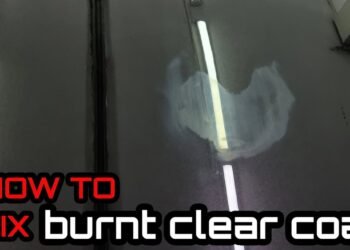Have you ever spilled antifreeze on your car and wondered, “Will antifreeze hurt my car paint?” It’s a common concern because antifreeze is a harsh chemical, and your car’s paint is what keeps it looking sharp and protected. You want to keep your vehicle in top shape, but accidents happen.
The good news is, if you act quickly and know the right steps to take, you can prevent permanent damage. You’ll discover exactly how antifreeze affects your car’s paint and learn simple, effective ways to clean it off before it leaves stains or dull spots.
Keep reading to protect your car’s finish and keep it shining like new.
Antifreeze And Car Paint
Antifreeze is vital for your car’s engine but can be risky for its paint. It often spills during maintenance or leaks. Knowing how antifreeze affects car paint helps protect your vehicle’s look. This section explains the chemical nature of antifreeze and its effect on paint surfaces.
Chemical Composition Of Antifreeze
Antifreeze is mainly made of ethylene glycol or propylene glycol. These chemicals lower the freezing point of coolant and raise its boiling point. It also contains corrosion inhibitors and dyes for color. The mix is designed to protect engine parts from rust and freezing damage. Some antifreeze types include additives that can be harsh on paint.
How Antifreeze Interacts With Paint
Antifreeze is sticky and can leave a residue on car paint. When left on the surface, it can break down the clear coat. This layer protects the paint from fading and scratches. The chemicals in antifreeze can cause dull spots or discoloration if not cleaned quickly. Also, the dyes in antifreeze may stain the paint over time. Quick removal prevents long-term damage and keeps the paint shiny.

Credit: www.theengineeringchoice.com
Potential Paint Damage
Antifreeze spills on car paint can cause damage if not cleaned quickly. The chemicals in antifreeze may harm the paint’s surface. Understanding the potential damage helps you protect your car’s finish.
Fading And Discoloration Risks
Antifreeze contains chemicals that can fade car paint color. The sticky residue can cause uneven discoloration. Left untreated, these spots may become permanent. Sunlight can worsen the fading by breaking down paint pigments. Even small spills can cause visible changes in paint shade.
Long-term Effects On Clear Coat
The clear coat protects your car’s paint from damage. Antifreeze can weaken this protective layer over time. This leads to dullness and loss of shine on the paint surface. Cracks or peeling of the clear coat may also appear. Regular removal of antifreeze helps maintain the clear coat’s strength and gloss.
Immediate Cleanup Steps
Immediate cleanup is crucial if antifreeze spills on your car paint. Acting fast reduces the chance of damage. Antifreeze contains chemicals that can harm the paint surface. Follow these simple steps to protect your vehicle’s finish and keep it looking good.
Rinsing Off Antifreeze Quickly
Use a low-pressure water stream to rinse off antifreeze. Start as soon as you notice the spill. This step removes most of the liquid before it dries. Avoid scrubbing at this stage to prevent spreading the fluid.
Using Mild Soap And Water
Mix mild car wash soap with water. Apply the solution using a soft sponge or wash mitt. Gently scrub the affected area to lift antifreeze residue. Be careful not to scratch the paint. Rinse thoroughly after washing to remove all soap and antifreeze traces.
Drying And Preventing Water Spots
Dry the cleaned area with a clean microfiber cloth. This stops water spots from forming. Make sure the surface is completely dry to avoid dullness. Proper drying helps maintain your car’s shine and prevents further paint damage.

Credit: www.mtfca.com
Handling Stubborn Residue
Removing antifreeze from car paint can be tricky, especially when residue hardens. Stubborn residue may not come off with just soap and water. It needs extra care to avoid damaging the paint surface. Handling these tough spots carefully keeps your car looking great. Below are effective methods to deal with lingering antifreeze residue safely.
Using A Clay Bar For Contaminants
A clay bar is a simple tool to remove tough contaminants on paint. Wet the clay bar and the car surface with water or a clay lubricant. Gently rub the clay bar over the affected area. This process lifts stubborn antifreeze particles without scratching the paint.
Using a clay bar restores smoothness and shine to the paint. It also helps remove other pollutants that soap might miss. Always follow the instructions on the clay bar package for best results.
Professional Detailing Options
Professional detailers have special tools and products for deep cleaning. They can safely remove antifreeze residue that home methods cannot. Detailers use polishing and paint correction techniques to restore the finish.
Getting a professional detail can protect your car paint in the long run. They also apply protective coatings to prevent future damage from chemicals like antifreeze.
Liquids That Harm Car Paint
Various liquids can damage car paint if spilled or left on the surface too long. Paint protects your car from rust and weather. Harmful liquids break down this protective layer and cause stains or fading. Knowing which liquids to avoid helps keep your car’s paint bright and smooth. Below are some common liquids that can harm car paint.
Brake Fluid And Gasoline Effects
Brake fluid is corrosive and can eat through paint quickly. Even a small drop can leave a dull spot or stain. Gasoline also damages paint by removing its shine and causing discoloration. Both fluids dry fast but leave lasting marks if not cleaned immediately. Avoid contact with your car’s paint and wash off spills right away.
Impact Of Acetone And Solvents
Acetone and other solvents dissolve paint layers easily. They strip away the clear coat that gives paint its gloss. These chemicals are often found in nail polish remover and paint thinners. A tiny spill can cause bubbling or peeling on the car’s surface. Never use acetone or strong solvents to clean your car.
Household Chemicals To Avoid
Common household chemicals like bleach, ammonia, and vinegar can harm car paint. They react with the paint’s finish and cause discoloration or dullness. These chemicals are not meant for car care. Use only products designed for automotive paint to avoid damage and keep your car looking new.

Credit: www.folsomlakehonda.com
Preventing Paint Damage
Protecting your car’s paint from damage is important for keeping its look fresh. Antifreeze spills can harm paint if left too long. Taking steps to prevent this damage helps your car stay shiny and new. Simple care routines create a strong barrier against harmful substances like antifreeze.
Using good habits regularly can keep your paint safe from stains and fading. Preventing paint damage means acting fast and using protective measures. These keep your car’s finish smooth and bright.
Regular Washing And Waxing
Washing your car often removes dirt and chemicals like antifreeze. Use mild soap and soft cloths to avoid scratching the paint. Clean paint lets wax stick better and protect the surface.
Waxing adds a layer that blocks harmful liquids from reaching the paint. It also helps water and dirt slide off easily. Apply wax every few months to keep this shield strong.
Protective Coatings And Sealants
Protective coatings offer long-lasting defense against spills and stains. These coatings bond with the paint and form a tough layer. Sealants work similarly but may last for a shorter time.
Both coatings and sealants stop antifreeze from soaking into the paint. They make cleaning easier and reduce the risk of fading. Consider applying these for extra paint protection.
Frequently Asked Questions
Will Antifreeze Ruin Car Paint?
Antifreeze can damage car paint if left too long due to its chemicals and stickiness. Rinse it off quickly to prevent fading or dullness. Use mild soap and water, then dry thoroughly to protect your paint’s finish.
How To Get Antifreeze Off Car Paint?
Rinse antifreeze off immediately with low-pressure water. Wash gently using mild soap and a soft sponge. Rinse again and dry with a microfiber cloth. For stubborn spots, use a wet clay bar to lift residue without damaging the paint. Act quickly to avoid staining or dullness.
What Liquid Will Ruin Car Paint?
Liquids that ruin car paint include brake fluid, gasoline, acetone, and acidic substances like bird droppings, coffee, and soda. These liquids strip the clear coat, cause stains, and lead to permanent discoloration if not cleaned quickly.
Will Straight Antifreeze Hurt My Car?
Straight antifreeze can harm your car’s engine and cooling system if not properly diluted. Use the correct mix to prevent damage.
Will Antifreeze Damage My Car’s Paint Immediately?
Antifreeze can cause dull spots if left on paint for long but usually does not harm instantly.
Conclusion
Antifreeze can damage car paint if left too long. Acting quickly helps protect your car’s finish. Rinse spills with water right away. Use mild soap and a soft cloth to clean. Dry the area fully to avoid water spots. Stubborn stains may need gentle clay bar treatment.
Taking these simple steps keeps your paint looking good. Prevent damage by removing antifreeze as soon as possible. Your car’s paint will stay bright and smooth this way.

















